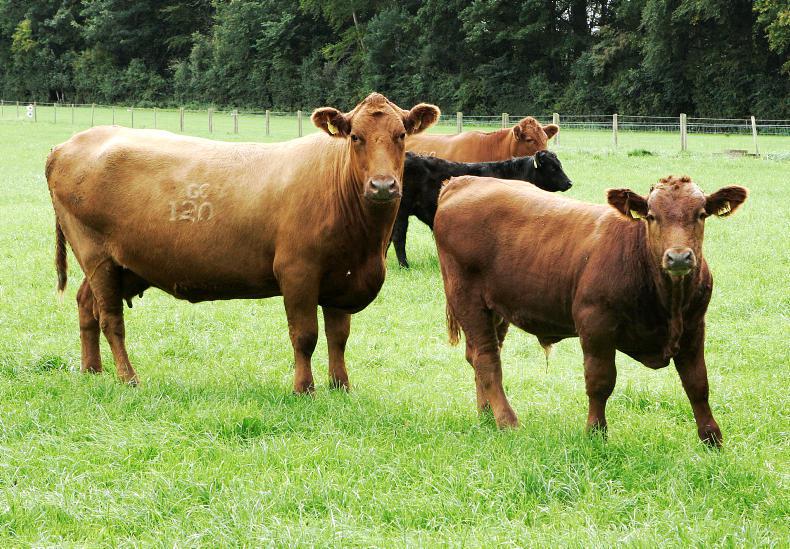With more changeable weather and cooler temperatures, livestock farmers should be on the alert for grass tetany and taking steps to supplement cows properly with magnesium.
Freshly calved autumn cows grazing on swards of lush, leafy grass or on silage aftermath are high-risk animals, but spring-calving cows are still susceptible to tetany in autumn.
Dry matter in grass is low during autumn and with less fibre in swards, grass tends to pass through animals quickly, meaning the cow has less time to absorb nutrients.
Prevention is always better than cure. Outlined are five steps that can help to reduce the risk of grass tetany this autumn.
1.Supplement with magnesium: Tetany is caused by a lack of magnesium in the cow’s diet. As cows cannot store magnesium, they need regular supplementation to reduce the risks associated with deficiency. Lick buckets are the easiest way to supplement cows with magnesium and the more buckets used, the better. As a rule of thumb, offer one bucket for every 10 cows in a grazing group. Putting magnesium in water troughs can also work. However, with low dry matter in swards, dew forming on grass and frequent showers of rain, cows are less reliant on drinking water. Therefore, there is a risk that they will not get sufficient magnesium through water troughs. Giving cows a magnesium bolus provides a slow release of minerals, which offers long-term cover but is more costly and time-consuming to administer.2. Feed meal: Feeding cows 2kg/day of a high magnesium ration can reduce the risk of tetany. Target thin cows, first-calved heifers and cows sucking twins immediately, as they will be under most nutritional stress and at a higher risk of tetany.3. Avoid grazing swards after slurry: Slurry contains high levels of potash (K), and potash inhibits magnesium uptake in grass. Therefore, where possible, avoid grazing cows on swards that have recently received slurry. These swards can be grazed by store cattle instead.4. Do not force cows to clean out swards: Do not force freshly calved cows to graze swards out tight to the ground. Holding cows in paddocks with low grass covers so they are fully grazed out will put cows under stress, and they may not be getting enough energy. Move cows to the next paddock early and use dry cows, or dry ewes, to clean out swards.5. Offer fibre: Offering some rougher forage, such as hay or straw, can reduce the risk of tetany as it slows down digestion. Simply open a bale and scatter on top of ground every morning or evening. Read more
Winter AI: making the right decisions ahead of winter breeding
Beef Management: listeriosis, housing and feeding
With more changeable weather and cooler temperatures, livestock farmers should be on the alert for grass tetany and taking steps to supplement cows properly with magnesium.
Freshly calved autumn cows grazing on swards of lush, leafy grass or on silage aftermath are high-risk animals, but spring-calving cows are still susceptible to tetany in autumn.
Dry matter in grass is low during autumn and with less fibre in swards, grass tends to pass through animals quickly, meaning the cow has less time to absorb nutrients.
Prevention is always better than cure. Outlined are five steps that can help to reduce the risk of grass tetany this autumn.
1.Supplement with magnesium: Tetany is caused by a lack of magnesium in the cow’s diet. As cows cannot store magnesium, they need regular supplementation to reduce the risks associated with deficiency. Lick buckets are the easiest way to supplement cows with magnesium and the more buckets used, the better. As a rule of thumb, offer one bucket for every 10 cows in a grazing group. Putting magnesium in water troughs can also work. However, with low dry matter in swards, dew forming on grass and frequent showers of rain, cows are less reliant on drinking water. Therefore, there is a risk that they will not get sufficient magnesium through water troughs. Giving cows a magnesium bolus provides a slow release of minerals, which offers long-term cover but is more costly and time-consuming to administer.2. Feed meal: Feeding cows 2kg/day of a high magnesium ration can reduce the risk of tetany. Target thin cows, first-calved heifers and cows sucking twins immediately, as they will be under most nutritional stress and at a higher risk of tetany.3. Avoid grazing swards after slurry: Slurry contains high levels of potash (K), and potash inhibits magnesium uptake in grass. Therefore, where possible, avoid grazing cows on swards that have recently received slurry. These swards can be grazed by store cattle instead.4. Do not force cows to clean out swards: Do not force freshly calved cows to graze swards out tight to the ground. Holding cows in paddocks with low grass covers so they are fully grazed out will put cows under stress, and they may not be getting enough energy. Move cows to the next paddock early and use dry cows, or dry ewes, to clean out swards.5. Offer fibre: Offering some rougher forage, such as hay or straw, can reduce the risk of tetany as it slows down digestion. Simply open a bale and scatter on top of ground every morning or evening. Read more
Winter AI: making the right decisions ahead of winter breeding
Beef Management: listeriosis, housing and feeding






 This is a subscriber-only article
This is a subscriber-only article










SHARING OPTIONS: